AMD Radeon HD 7950 Review Feat. Sapphire & XFX: Sewing Up The High-End Market
by Ryan Smith on January 31, 2012 9:02 AM ESTPower, Temperature, & Noise
As always, we wrap up our look at a new video card with a look at the physical performance attributes: power consumption, temperatures, and noise. With the 7970 we saw what is possible with Tahiti when AMD is trying to maximize their performance, but how will things stack up with the lower power 7950? Let’s find out.
Please note that we’ve decided to include our reference 7950 in these charts, even though none of AMD’s partners will be shipping a card in this exact configuration. Typically we wouldn’t do this, but as our partner cards are overclocked it’s the only stock performance card we have. Furthermore it provides an interesting contrast to the 7970, since they’re built on the same hardware. With that said, the Sapphire and XFX cards are far more representative of the cooling performance you’ll see with retail cards.
| Radeon HD 7900 Series Voltages | |||||
| Ref 7970 Load | Ref 7950 Load | XFX 7950 Black Edition DD | Sapphire HD 7950 Overclock Edition | ||
| 1.17v | 1.093v | 1.093v | 0.993v | ||
Since the launch of the 7970 we’ve finally seen the release of tools that can read the VIDs of Tahiti GPUs. For our review we have four 7950s in our hands, and one of them is not like the others. Both of our AMD cards and our XFX card have a VID of 1.093v, however the Sapphire card is significantly lower. So low that we thought this was an error and went through 3 different tools just to be sure it wasn’t. Sure enough, our Sapphire 7950 does indeed ship at 0.993v, roughly 0.1v below our other 7950s and lower than what we thought Tahiti could operate at. The fact that the Sapphire is overclocked makes this all the more impressive, and we’ll see how this plays out in a moment.
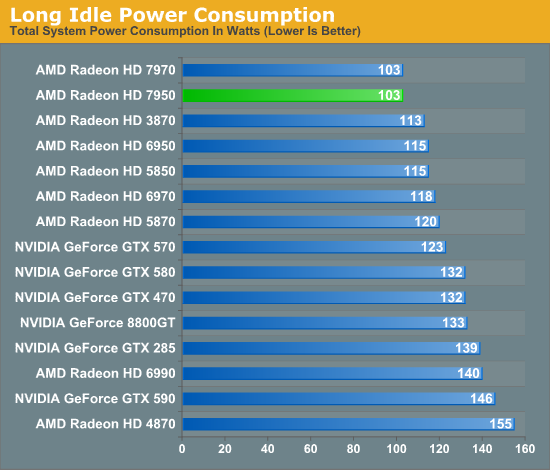
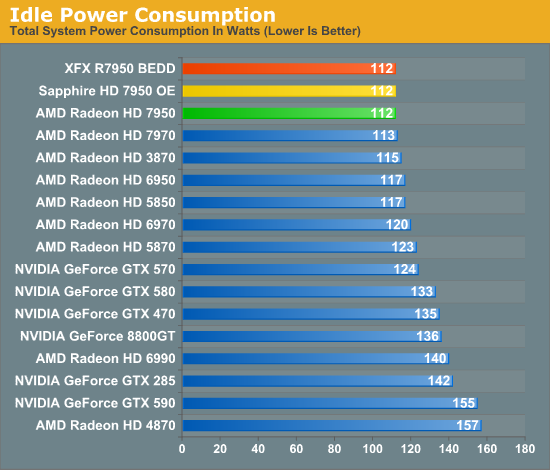
Starting as always with idle power, there aren’t many surprises here. Power islands not only give the 7000 series great idle power characteristics, but they also greatly diminish the difference between GPUs when it comes to idle power consumption. As a result the entire 7950 lineup is at 112W at the wall, consistently 1W below the 7970 and a good 20W below the GTX 580.
The situation with long idle power is much the same. As AMD’s ZeroCore power technology effectively powers down all the workhorse components of the GPU, the only thing left is a small constant load from the bus controller, giving us 103W on both the 7970 and 7950.
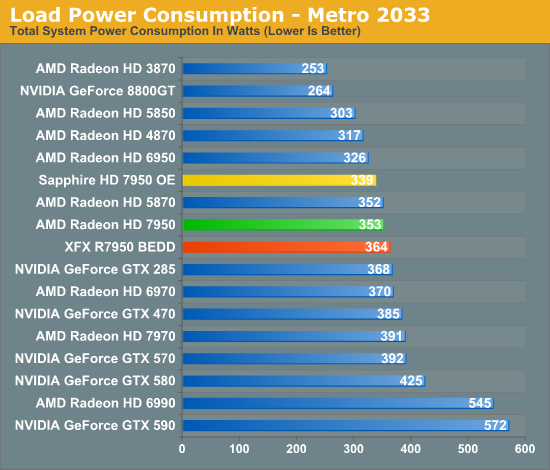
Meanwhile it’s under load that the physical performance attributes of the 7950 really begin to shine. Compared to the GTX 580, our 7950 equipped testbed draws 72W less at the wall; the performance advantage we saw in Metro earlier makes this all the more impressive. The 7950 also pulls less power than the 7970 here as we’d expect, leading to a difference of 38W at the wall.
As for our two partner cards, the Sapphire does particularly well here thanks to its very low VID, while the XFX does a bit worse than the reference 7950, likely due to its stock VID coupled with the factory overclock.
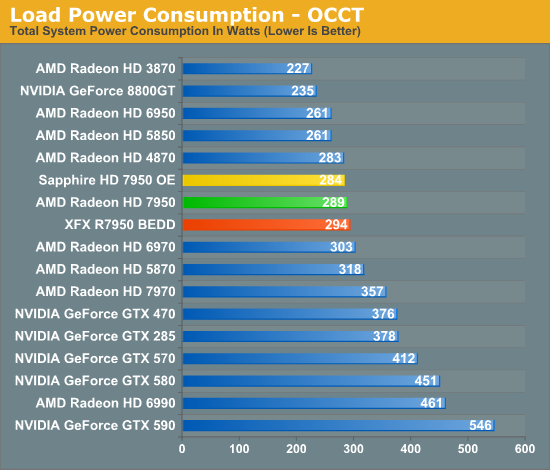
Under OCCT our 7950 cards begin to clump together in spite of their differences. With the reference 7950 at 289W, the Sapphire and XFX cards pull 5W less and 5W more respectively. It’s interesting to note here that as with the 7970 compared to the 6970, the 7950 is pulling more power than the 6950 even though both cards should have the same PowerTune limit. In practice it’s clear that the 7950 is more power hungry than the 6950 despite the PowerTune limit, so this needs to be taken into account accordingly.
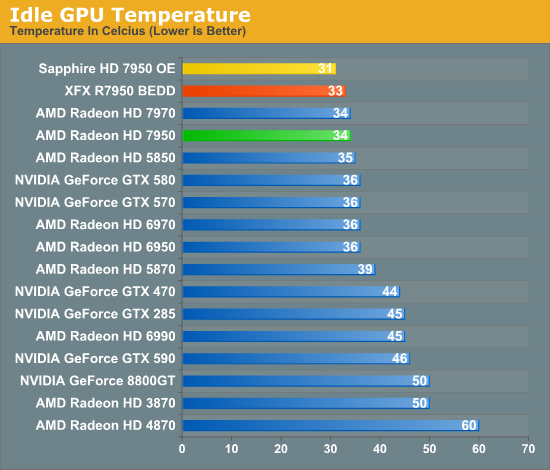
As the use of power islands has brought down the idle power consumption, so has it brought down idle temperatures. The 7970 already did well here and the reference 7950 does similarly well, while the open air coolers on the XFX and Sapphire cards take this one step further, pulling temperatures down to 33C and 31C respectively.
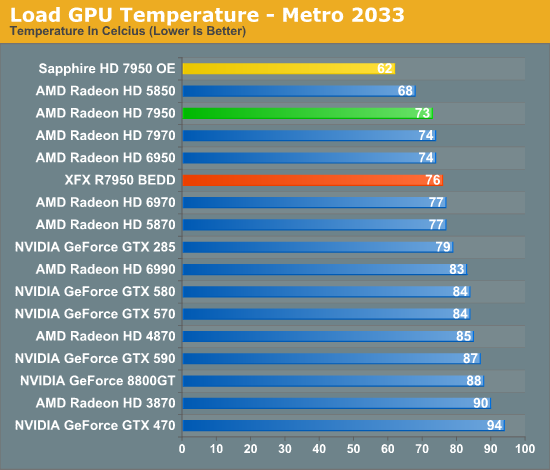
Meanwhile load temperatures are a mixed bag among the 7950s, and it’s not all good. Starting with the Sapphire 7950, we have an open air card with a very low VID that’s performing as we’d expect. The Sapphire card is extremely cool here, and this kind of gap is consistent with other near-200W cards we’ve seen in the past. Elsewhere, in the middle is the reference 7950, which is using AMD’s fully exhausting blower; this pushes almost all the heat outside of our case, but it does keep temperatures higher, and in this case very close to the 7970.
Finally we have the XFX card, which is the odd man out. The R7950 BEDD is an open air cooler and we’d expect performance closer to the Sapphire card, not performance worse than the reference 7950.

Under OCCT the results closely mirror what we saw with under Metro. The Sapphire is well in the lead among the 7950s, followed by the reference and XFX cards. With virtually every other card pushing 80C or higher, the 7950s are in good company here, particularly compared to the 88C GTX 580 due to the lack of comprehensive power throttling on NVIDIA’s part.
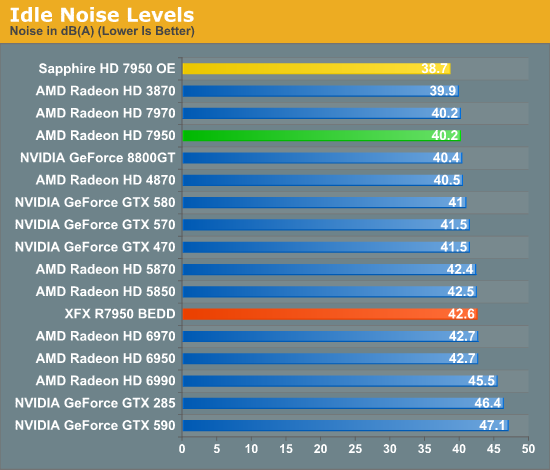
Last but not least we have our look at noise. The 7970’s cooler was already doing quite well at 40.2dB, but Sapphire takes this one step further with their open air cooler, bringing their idle noise down to 38.7dB. XFX on the other hand doesn’t fare as well, as their Double Dissipation cooler can’t rev down quite enough, coming in louder than the reference 7950 at 42.6dB.

It’s looking at load noise that particularly drives home the potential of the Sapphire 7950. Sapphire has exploited their open air cooler for all it's worth, and as a result it’s quieter under load with Metro than half our cards are at idle—41.3dB is only 0.3dB louder than the GTX 580 at idle, never mind the other 7950s. The XFX meanwhile fares really, really poorly here for an open air cooler. This doesn’t appear to be a matter of an aggressive fan profile as we’ve already seen that its temperatures are close to the reference 7950, so there’s more going on here.

Even under OCCT the Sapphire 7950 still only hits 42.8dB, a particularly impressive showing when you consider that AMD’s reference 6900 series cards idle at 42.7dB. It’s not a silent card, but for most practical purposes it’s damn close. Meanwhile the XFX 7950 again fares poorly, coming in at 56.8dB. This is still quieter than the GTX 580 in this case, but it’s clearly disappointing.
Wrapping things up, as we stated in our introduction the vast selection of 7950s means that there’s going to be a wide range of performance for 7950 cards, and these results drive home the point nicely. The Sapphire 7950 simply gushes potential—not only is it a factory overclocked card, but it gives off so little heat and noise compared to anything else in its performance class that it’s unrivaled. Much of this no doubt is due to the extremely low VID of our sample and I strongly suspect that this a better voltage than the bulk of Sapphire 7950s can actually hit, so our results are most likely better than average. Still, even with more voltage there’s still plenty of thermal and acoustic headroom for the Sapphire 7950 to work with, so it should still be a well performing card regardless.
Overall it’s results like what we’ve seen with the Sapphire that are a large part of why AMD’s partners are strongly favoring open air coolers. But with that said, that potential can only be reached in a case with good airflow, meaning that the Sapphire 7950 (or any other open air 7950 for that matter) is likely a poor choice for a cramped case. Furthermore all of these open air cards are poor choices for CrossFire if they need to be directly adjacent to each other. A lot of boards offer usable PCIe x16 slots farther away from their first x16 slot, but this is not the case for all boards. Ultimately the lack of 7950 cards using a fully exhausting blower is definitely going to limit the CrossFire potential of the 7950.
Finally, we have the XFX 7950 BEDD. The 7970 BEDD was a very impressive card; the 7950 BEDD is not. It’s not possible to completely isolate any specific reason for the 7950 BEDD’s poor performance, but the most likely factors are the GPU quality and the ability of the card to transfer heat between the GPU and heatsink. With regards to quality, if the Sapphire 7950 has among the best 7950 GPUs then the 7950 BEDD has an average GPU if not worse; 1.093v is the same as our reference cards, but there’s still room for quite a bit of variance. Whereas when we’re looking at heat transfer we have to look at the much smaller vapor chamber the 7950 BEDD uses compared to the 7970 BEDD, along with what at first glance looks like too much thermal paste.
Given our temperature and power consumption data we’re heavily favoring the heat transfer theory; the 7950 BEDD just isn’t very good at transferring heat from the GPU. This is not to say that the 7950 BEDD is a bad card—our results are reasonable for a 200W card—but we’ve seen much better in the 7970 BEDD, never mind the other 7950 cards.










259 Comments
View All Comments
Galidou - Sunday, February 5, 2012 - link
Oh wait, wait, the 9800gx2 was priced 150$ lower than the GTX 280 and was performing more than gtx 280!! LOL speak about mispricing.... LOL OMG THAT'S RIDICULOUSGalidou - Sunday, February 5, 2012 - link
LOL that 7970 story pricing like it was the worst decision a Video card manufacturer ever made is so ridiculous chizow, it'S not a good decision either, we would all like to see lower prices considering we know the size of the die under the hood and we know it can be priced lower.But that GTX 280 thingy because Nvidia was thinking they had no competition was a little like taking people for DUMMIES. The radeon 4870 wasn't so mispriced, it was the gtx 280 that WAS. The GTX was uber big but didn'T justify over triple the price of 8800gt or higher price than a 9800gx2 considering the performance of those parts..... HELL NO.
In the end, I prefer a pricing according to performance than being taken for a DUMMY by a company leading the technology with a little more performance...
chizow - Sunday, February 5, 2012 - link
Like I said Galidou, the GTX 280 absolutely earned the original MSRP. It was a true flagship card in every respect and maintained the price:performance increase you would expect from a new next-gen GPU over its predecessor.You still haven't refuted this because again, the data is all out there. It was over 1.5x faster than the 8800GTX/9800GTX and roughly the same speed as the 9800GX2, the minimum baseline expectations anyone should have for a new flagship card on a new arch/gen/process.
AMD was the one who mispriced their card at the time they could least afford to do so. Some like myself argued they just didn't know how to make money. They could've easily priced it at $400 and STILL forced Nvidia to drop prices on the GTX 280 and especially the GTX 260.
But yes, Nvidia looked horrible after that decision but did right by their customers by issuing rebates. Now AMD is in the exact same position and stands to look badly with this pricing. Do you really think they will do the same if Nvidia forces them to cut prices on these parts? Its OK, you can say a bad thing about AMD too. ;)
chizow - Sunday, February 5, 2012 - link
We've already covered this, because with the exception of very rare and extraordinary increases like the 8800GTX or 9700pro, 2x increases over last-gen flagships are NOT normal.The GTX 280 was easily 2x faster than the 8800GT, but the 8800GT was a refresh mid-range performance product. Whatever price:performance discount it carried already existed compared to the high-end parts of the time like the 9800GTX and 9800GX2, where it cost significantly less for excellent performance.
Similarly, in these last few generations of cards mid-range cards like the GTX 460 and GTX 560 can be had for less than half of what a GTX 480 or GTX 580 cost but they perform much better than the cost would indicate. Obviously the top Kepler does not need to be 3x faster than the GTX 560 in order to command a $500 price tag commensurate with the flagship slot.
In summary, the top cards do command a premium and determine the pricing for all cards that follow, but their merit for commanding that top price is judged against previous cards and generations.
Its already become obvious that 15-25% increase from Tahiti over Fermi doesn't carry enough mustard to push the stack, since its momentum wasn't enough to even shift the metric at the second stop, the 7950.
Galidou - Sunday, February 5, 2012 - link
It was the same performance than a 9800gx2 when it was in 2560* resolution because of memory, for the rest(99.5% of the people with 1080p or less back then) the 9800gx2 was truncating the gtx280 for 150$ less.chizow - Sunday, February 5, 2012 - link
No it was trading blows with the 9800GX2 and beating it at the highest resolutions and AA settings that mattered for people looking to upgrade.This is going to happen with any new flagship part because of the overall increased pipeline. High-end cards are meant to push high-end settings and resolutions because what you have is usually enough at lower end settings. This is why we "upgrade".
Regardless, X2 parts are always going to carry some performance advantage at cheaper prices but that's because single-GPU always carries a premium that goes with being the top single-GPU flagship.
You can look at any forum and you see this decision making process all the time with both last-gen GPUs and newer ones.
But back to the point. Flagship next-gen GPUs do generally tend to compete with last-gen X2 in performance, not always a convincing win across the board, but enough to effectively retire those cards. That's clearly not the case with the 7970.
Galidou - Sunday, February 5, 2012 - link
Nope you still can,T say something wrong about Nvidia you corrected them by saying they issued rebates to their customers, and AMD is not in the same position, they did not price it for dummies, it'S accordingly to it'S performance... wow when will you realize triple the price and according to it'S performance is different? that's all I wan you to say lol!chizow - Sunday, February 5, 2012 - link
Is the 7970 triple the performance of the 6950? So then how does it justify 3x the price?Its amazing how you want to try to hold Nvidia to this flawed logic and dismiss it when the 7970 fails even WORST at meeting it.
Again, this just makes you look incredibly stupid or incredibly dishonest, neither of which are flattering.
Galidou - Sunday, February 5, 2012 - link
it'S not triple the price of 6950 it's a LITTLE more than double, fi you have to lie this discussion is over..... when I said triple the price of the 8800gt I was gentle, 650$ for gtx 280 while 8800gt were selling for I remember I got one for 180$ so that's in fact three times and a half, plus we're comparing a 1gb video card price to a 3gb while GTX 280 and 8800gt had 256mb difference.... Now that I see you have to lie I don't want to continue this, I may be not right in EVERYTHING I say but I ain't lying big time....I prefer to be honest in my opinion than being dishonest in a certitude.....
Ati radeon 3870 sucked big time, they never offered as good a competition to Nvidia after the X1xxx products in my opinion and Nvidia have(most of the time) got better drivers, I prefer their interface, I dislike catalyst. Here's what I have to say about ATI and I have not much wrong about Nvidia but at least I can say I see both side of the medal.
Good luck in the future, peace out.
Galidou - Sunday, February 5, 2012 - link
I was offering you my perception ok I played the troll but I never lacked respect to you, I'm not saying you are stupid or anything while you did, respect is something you can't buy.I may be poking your opinions because you see them as fact but thing is perception is different for everyone. I do not see anything SO wrong in the pricing of the 7970 while you obviously see something very bad in it. I can'T make you see my point of view so I guess you and I are right, depends for who reads us.
respect.